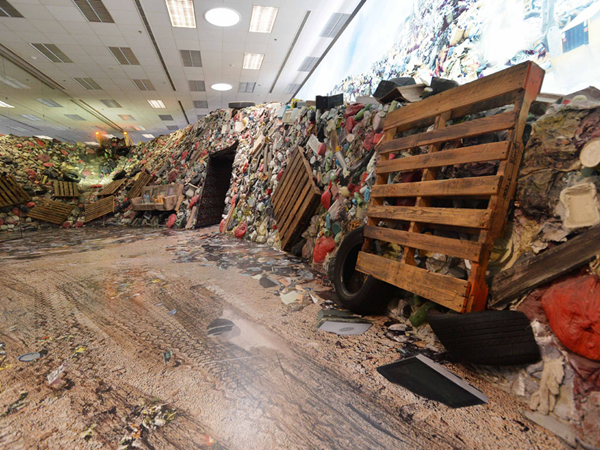Putting waste in its place
 0 Comment(s)
0 Comment(s) Print
Print E-mail China.org.cn, May 12, 2014
E-mail China.org.cn, May 12, 2014
"Oh, it's so dirty!" "It's full of garbage!" the primary students exclaim, staring at a life-size three-dimensional model of the Nim Wan landfill -- an eye-popping feature of the Ecopark visitor centre in Tuen Mun.
 |
|
The Ecopark visitor centre has a "waste wall" made from disinfected genuine waste and glass fibre that silently tells a disturbing story. |
The "waste wall", made from disinfected genuine waste and glass fibre, silently tells a disturbing story: The city is being overrun with trash.
"If there was this much waste in my community, I would feel scared. Would it topple over and bury someone? It makes me feel so uneasy," one student said as he eyed the simulated trash heap.
"I couldn't imagine the city street being full of garbage like a landfill. Rubbish which can be recycled should be put into the recycle bin," another student said.
The Environment Bureau launched its Blueprint for Sustainable Use of Resources last May, urging people to "use less, waste less" to solve the city's waste-management problem.
Island Resort resident Mrs Li is one among many who take this motto to heart. She collects household waste paper, and cleans drinks cans and plastic containers, before bringing them to her block's recycling bins for recycling.
"This is no trouble. It's a simple habit I developed at a young age, long before people started talking about environmental protection," she said.
Even if every city resident were as zealous in reducing waste and recycling as Mrs Li, helping to keep our environmental targets on track, there will still be the need to dispose of about 10,000 tonnes of waste every day in 2017. This is why the bureau proposes to expand the three landfills and build a modern incinerator.
There are concerns that an incinerator would affect air quality, producing dioxins which could damage health. Prof Irene Lo of the University of Science & Technology's Civil & Environmental Engineering Department thinks otherwise. "Modern incinerators do much more than simply burning garbage," she said, adding they contain technologies that are leaps and bounds ahead of their predecessors.
Modern incinerators use "3T" technology -- for temperature, turbulence and time -- that control pollution, Prof Lo said. Using high temperature - over 850 degrees Celsius -- and high turbulence to mix waste with oxygen thoroughly ensures complete combustion. Waste and flue gases are superheated for at least two seconds to reduce air pollutants.
The incinerators also have air pollution-control devices to remove pollutants including particulates, dioxins, heavy metals, nitrogen oxides, and acidic gases, to ensure the flue gas meets the exacting European Union standard.






Go to Forum >>0 Comment(s)